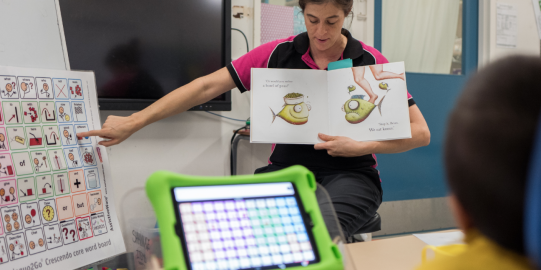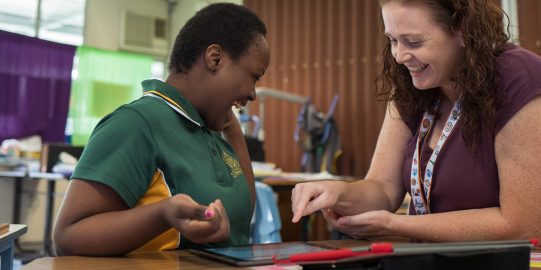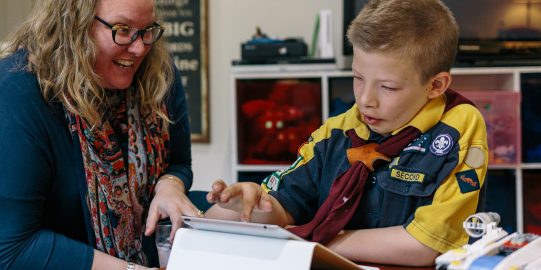Augmentative and Alternative Communication (AAC) takes time. AAC learners need many opportunities to see their AAC system being used to communicate real messages in everyday situations before they can use their system consistently and effectively.
When teams give up too soon
In practice, we often see the teams supporting AAC users give up too soon. They try the AAC system for a few weeks. Maybe they set up some folders or buttons. Perhaps they do modeling during snack and circle time. They try prompting the AAC user to give the “correct” answers. When the AAC user does not respond in the way they expect or wish, they assume the AAC user is not ready. They might also assume that the selected AAC system is the wrong one.
Often they give up using the AAC system. If the AAC system is continued to be used, it is often simplified. A simple AAC system makes it impossible to communicate anything novel or interesting. None of this helps an AAC user achieve successful communication.
Some think AAC systems are highly intuitive and the AAC user should just know how to use it. AAC learners cannot do this without any practice or instruction.
We need to realize that learning an AAC system, or any language system, takes practice and time. Jane Korsten, OTR, reminds us that:
“It is critical for an individual to not only have symbols, but also to have experience with those symbols in a symbol rich environment / print rich environment. The typically developing child will have been exposed to oral language for approximately 4,380 waking hours by the time he begins speaking at about 18 months of age.
If someone is using a different symbol set and only has exposure to it two times a week, for 20 – 30 minutes each, it will take the alternate symbol user 84 years to have the same experience with his symbols that the typically developing child has with the spoken word in 18 months!!!” -Jane Korsten, OTR, QIAT ListServe, 4/4/2011
Be persistent
The truth is, that for AAC to work, we need to be persistent. We need to try and try again. We need to give AAC time, real time to be established. We start with a balanced AAC system, and then we need to:
- Model regularly and reliably. Start modeling. Then model more.
- Work with Communication partners so everyone is prompting and responding to the AAC user appropriately.
- Make sure the AAC user is engaged and motivated to communicate.
- Put many activities in place that will support and build language and continue the momentum toward successful AAC.
Persistent and consistent use of good AAC strategies are essential for success. AAC takes time.
Make a plan for success
Look at the tools and strategies you want to put in place to achieve successful AAC. Set goals for the team as to how these strategies will be used. Set timelines to achieve these goals. Our chances of success are greater when the team is on board with goals and direction.
Celebrate small successes
When an AAC user makes a positive step with communication, we can build on this success. First celebrate the success! Take photos and videos of success stories to share with other members of the team. Next, look at what worked, what happened and who did what… and do that again!
Also, don’t give up when things go wrong. When things are challenging, or feel like they are not working, it is important to keep trying. You can review situations and identify difficulties and barriers. Problem solve these with the team.
Overcome the Roadblock
Don’t give up on AAC! Give AAC time! There is so much to be achieved when we give a voice to AAC users!
Take the test: Check the Learn AAC Guide to see where you are in establishing AAC for an AAC user. This may help you overcome any roadblocks stopping you from success!
Links & references
- Beukelman, D., & Mirenda, P. (2013). Augmentative and Alternative Communication (4th Ed). Baltimore: Paul H. Brookes.
- Cummings, Marlene. (2015)4 Things to consider when embracing the new norm. [Blog post]
- Hartmann, Amanda. Dos and Donts article on modeling. [Blog post]
- Romski, M., & Sevcik, R. (2005). Augmentative Communication and Early Intervention: Myths and Realities. Infants and Young Children, 18(3), 174-185.
- Sennott, S., Light, J., & McNaughton, D. (2016). AAC Modeling Intervention Research Review. Research and Practice for Persons with Severe Disabilities, 4(2), 101–110.
- Zangari, Carole. (2013). More ideas for supporting pre-intentional communicators. [Blog post]




